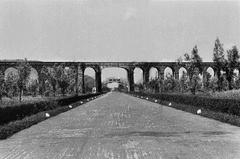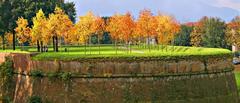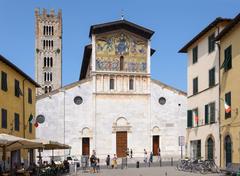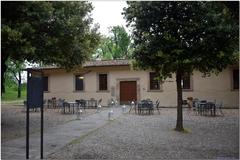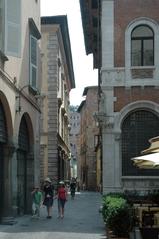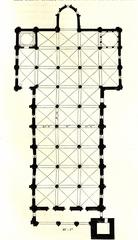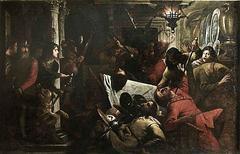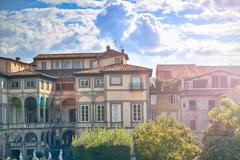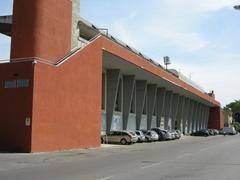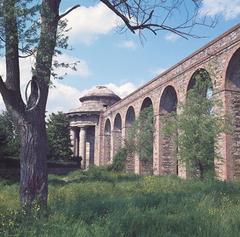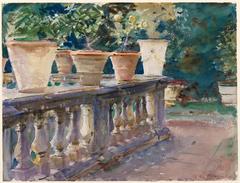
Certosa di Farneta Visiting Hours, Tickets, and Lucca Historical Sites Guide
Date: 04/07/2025
Introduction to Certosa di Farneta
Nestled in the tranquil Tuscan countryside just outside Lucca, the Certosa di Farneta stands as a remarkable testament to centuries of monastic tradition, architectural evolution, and humanitarian courage. Founded in 1327, this Carthusian monastery is distinguished by its harmonious blend of Gothic, Renaissance, and Baroque styles, reflecting the contemplative ideals of the Carthusian Order. Over the centuries, Certosa di Farneta has not only served as a spiritual retreat but also played pivotal roles in regional history, from supporting local communities to sheltering refugees during World War II.
Today, the monastery welcomes visitors seeking spiritual reflection, artistic inspiration, or an escape into serene landscapes. This guide provides detailed information on visiting hours, ticketing, site accessibility, guided tours, and nearby attractions in Lucca, ensuring a rewarding visit to one of Tuscany’s most significant historical sites. For real-time updates and planning, refer to the official Certosa di Farneta website and the Visit Lucca tourism portal.
Historical Overview
Origins and Foundation
The Certosa di Farneta was established in 1327 under the patronage of local noble families and church authorities, reflecting the Carthusian preference for secluded, rural environments conducive to prayer and contemplation. Its foundation was part of a broader expansion of monastic life in Tuscany during the late Middle Ages, with Farneta quickly becoming a center for spiritual retreat and theological study (BEWEB - Archivio della Certosa di Farneta).
Architectural Evolution
The monastery’s architecture evolved from its initial Gothic design—characterized by pointed arches and simple, austere interiors—to incorporate Renaissance and Baroque elements in subsequent centuries. The layout features a central church, two cloisters, monks’ cells, refectory, library, and agricultural outbuildings. Renaissance and Baroque renovations introduced frescoes, stucco decorations, and ornate altarpieces by local artists, blending artistic elegance with monastic simplicity.
Cultural and Religious Significance
As a Carthusian monastery, Certosa di Farneta was a hub of spiritual and intellectual activity. The monks dedicated themselves to prayer, silence, and manuscript production, contributing to Tuscany’s theological and cultural development. The monastery also provided refuge during times of conflict and plague, supporting the local community through charity and agricultural innovation.
Notable Historical Moments
The Certosa faced suppression under Napoleonic rule in 1808, with the complex repurposed and many treasures lost. The monks returned in the 19th century, only to encounter new challenges following Italian unification. During World War II, the monastery became a haven for Jews, partisans, and refugees, with several monks sacrificing their lives to protect others—a legacy honored today with memorials and annual commemorations (Museo della Memoria).
Visiting Certosa di Farneta: Practical Information
Visiting Hours
- Regular Schedule: Open weekends and public holidays, typically from 10:00 AM to 6:00 PM.
- Seasonal Variations: Visiting hours may change seasonally or during religious events. Always confirm current hours on the official website or with the Visit Lucca tourism office.
Tickets and Admission
- Ticket Prices: Admission generally ranges from €5 to €8 per person, with discounts for students, seniors, and children.
- How to Buy: Tickets are available on-site and online via authorized platforms. Group visits and guided tours should be booked in advance to ensure availability.
- Area Access: Some monastic areas remain off-limits to preserve the contemplative environment.
Accessibility
- Mobility: While ramps and accessible restrooms are available in key areas, some sections retain uneven surfaces and historic stairs. Visitors with mobility needs are advised to contact the monastery in advance for assistance.
- Parking: Ample parking is provided near the entrance.
Guided Tours
Guided tours—often available in Italian and English—offer insights into the monastery’s history, art, and spiritual traditions. Tours must be arranged in advance, especially for groups or non-Italian speakers.
Photography
- Permitted: Outdoor photography is generally allowed.
- Restrictions: Photography inside the church and monks’ quarters is restricted to maintain the sanctity of the site.
Getting There
- By Car: The Certosa di Farneta is located approximately 10 km west of Lucca’s city center. The easiest access is by car, with clear signage and parking near the entrance (Google Maps).
- Public Transport: Limited bus services operate from Lucca; a taxi or shuttle is recommended for convenience.
Architectural and Artistic Highlights
The Certosa di Farneta’s architectural ensemble reflects centuries of evolution:
- Church: Features a simple façade and a nave adorned with frescoes and altarpieces from the 16th and 17th centuries.
- Cloisters: Peaceful arcades and gardens central to Carthusian life.
- Artworks: Includes works by local Tuscan artists, intricately carved wood furnishings, and decorative religious artifacts.
- Materials: Traditional Tuscan materials such as limestone, brick, and terracotta blend the monastery into its rural landscape.
The layout is designed to balance communal worship with private contemplation, creating a serene setting for visitors (Lucca Musei).
Cultural and Humanitarian Legacy
The Certosa di Farneta is celebrated not only for its artistic and architectural merit but also for its moral legacy. Its monks’ wartime bravery—sheltering refugees at great personal risk—has made the site a symbol of resistance and compassion, commemorated with plaques and annual events. The archives and collections, preserved by the Italian Catholic Church, are invaluable resources for historians (BEWEB - Archivio della Certosa di Farneta).
Nearby Attractions and Suggested Itineraries
Enhance your visit to Certosa di Farneta by exploring these Lucca-area highlights:
- Lucca’s Historic Center: Renaissance walls, medieval towers, and Romanesque churches (Comune di Lucca).
- Villa Reale di Marlia: A lavish villa with extensive gardens (Villa Reale di Marlia).
- Puccini’s Birthplace: Museum dedicated to the famed composer (Puccini Museum).
A recommended itinerary: morning at Certosa di Farneta, lunch at a local trattoria, and an afternoon exploring Lucca’s city center or nearby villas.
Tips for a Memorable Visit
- Ideal Times: Spring and autumn offer mild weather and fewer crowds.
- Language: Basic Italian is helpful; English is spoken by many staff and guides.
- Local Cuisine: Try tortelli lucchese, farro soup, and local wines at nearby restaurants.
- Souvenirs: Small items and guidebooks may be available for purchase on-site.
- Etiquette: Respect the peaceful environment, dress modestly, and follow photography rules.
Visual Resources
Enhance your visit by previewing images of Certosa di Farneta’s architecture and artworks on official tourism sites. Some offer interactive maps and virtual tours for remote exploration.

Frequently Asked Questions (FAQ)
Q: What are the Certosa di Farneta visiting hours?
A: Open weekends and public holidays, 10:00 AM–6:00 PM. Confirm current hours online.
Q: How much are tickets?
A: €5–€8, with discounts for students, seniors, and children.
Q: Are guided tours available?
A: Yes, by prior arrangement; English tours can be requested.
Q: Is the monastery fully accessible?
A: Most key areas are accessible, but some historic sections have steps and uneven surfaces. Contact the site in advance for assistance.
Q: What other sites are nearby?
A: Lucca’s city center, Villa Reale di Marlia, and Puccini’s Birthplace are all within easy reach.
Preservation and Legacy
Today, Certosa di Farneta is protected as a cultural and religious monument, valued for both its historical artistry and humanitarian legacy. Its story of faith, charity, and resilience continues to inspire, offering a profound experience for all visitors. Annual memorial events recall the monastery’s role in World War II, and ongoing restoration efforts ensure the preservation of its treasures for future generations.
Plan Your Visit
For the latest information on hours, tickets, and guided tours, consult the official Certosa di Farneta website and Visit Lucca tourism portal. Download the Audiala app for audio guides and updates, and follow us on social media for travel tips and cultural insights.
Sources and Further Reading
- BEWEB - Archivio della Certosa di Farneta
- Visit Lucca Tourism
- Cathopedia’s entry on Certosa di Farneta
- Visit Tuscany
- Museo della Memoria: Certosa di Farneta WWII History
Certosa di Farneta remains a living testament to Tuscany’s spiritual, cultural, and artistic heritage. Whether you seek reflection, discovery, or inspiration, this historic monastery welcomes you to share in its enduring legacy.

